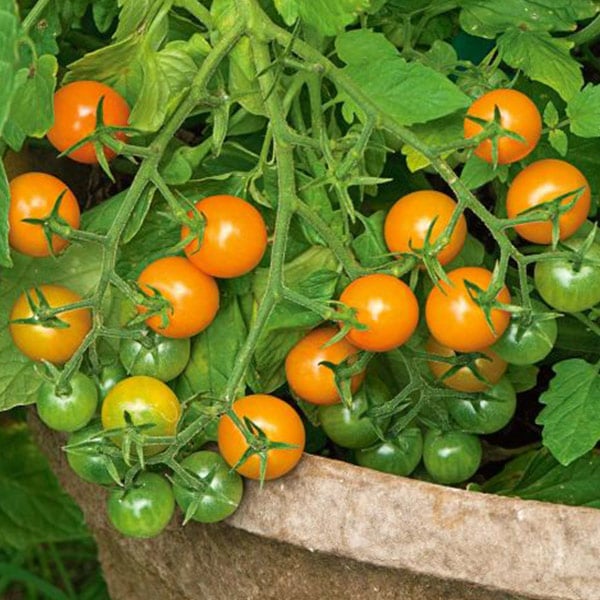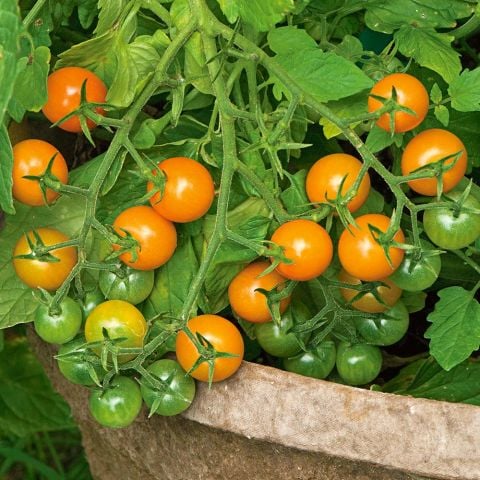Tomatoes: How to Grow

Nothing tastes quite as good as a ripe Tomato picked right off the vine. As long as you have a spot that receives eight hours of sun a day throughout the summer, you can grow your own. It just takes a little planning. First, consider where you will plant and how you want to enjoy your crop. Read on, and we'll help you have success.
Tips for Growing Tomatoes
When shopping for Tomato plants, it helps to understand the common terminology used to describe their growth habit:
Determinate means the plants stop growing at a certain height, rather than continuing to grow all summer. Their fruits ripen all at once. Determinate Tomato plants work well in containers because they are more compact and need less staking.
Indeterminate Tomato plants are a good choice for gardens, as these varieties continue to grow as long as the weather is warm and sunny, and produce higher yields. Their vines will climb or sprawl out over the ground, so you'll need to use stakes or cages, or cover the ground with mulch to keep the fruits from touching the soil.
"Ripens 70 days from transplant" means fruits will ripen about 70 days from the date you plant this particular Tomato variety in the ground or in a container.
Each Tomato plant variety offers different features, so read plant labels and descriptions carefully to learn more. As you make your selections, keep these points mind:
- For containers, look for words like compact, patio, or determinate for best success. However, if you use large containers and have room for sturdy stakes or plant cages in them, you can grow indeterminate varieties as well.
- Think about how you want to enjoy your crop. Larger Tomatoes for slicing, paste type for sauce or juice, cherries for salads and garden grazing, heirlooms for a taste of old fashioned goodness. Note: heirlooms are not as resistant to plant diseases as many new hybrids are...but their taste more than makes up for that.
- First-timers often over-buy, so we recommend starting with a smaller number of plants and as you gain confidence and experience, expand the following year.
- Finally, add a few herbs to your garden. They are the perfect kitchen companions for fresh or cooked Tomatoes. One of our favorite summer salads is nothing more than Basil leaves tossed with Tomatoes, mozzarella, and olive oil.
Tomato Plant Care On Arrival
Your plants have just spent up to 3 days without light or water and may have yellow leaves or show evidence of wilting. Through years of shipping experience, we have found that more than 98% of these plants will survive and thrive if you follow the simple care instructions below.
1. Please take your plants out of the shipping box as soon after their arrival as possible, taking care not to damage any stems or leaves as you free the plants from the cardboard packaging.
2. If the soil is dry, water gently but thoroughly from above or set the pot in a saucer of water for an hour or so -- just long enough for the soil in the pot to become thoroughly moist, but not soggy.
3. Place your plants in bright but indirect light indoors or, if temperatures permit, outdoors in the shade, sheltered from the wind. Don't put your plants in full sun right away because their leaves are tender after the trip and could be burned (sunscalded) or fall off if exposed to too much sun too soon. Allow your plants to adjust gradually over the next few days to increasing amounts of sunlight.
4. We've tried to time the shipping of our young plants so that they arrive at or near the frost-free date in your climate zone. If, however, the weather is still raw and a frost seems likely, transplant your plants into larger pots, taking them outside during the day when the weather is mild and bringing them in whenever frost or blustery cold weather threatens. Young plants are more tender than mature plants, and even if the last spring frost is already past, near-freezing temperatures and cold spring winds are capable of killing your new plants. Expose your young plants to outdoor conditions gradually, giving them a chance to harden off before they're planted out. When the weather does settle and both days and nights become reliably mild (night-time temperatures should remain above 50°F), then it's time for planting out.
Planting Tomato Plants Outdoors
When the weather is warm and settled, choose a planting location in full sun with rich, fertile soil and good drainage. To reduce soil-borne disease problems, plant tomatoes where you haven't grown them or potatoes in the past 3 years. Allow plenty of space (about 3') between plants so air can circulate. This helps prevent disease by keeping the leaves and stems dry, and facilitates pollination.
Dig a hole that will generously accommodate the plant's root ball, and mix compost or aged manure and a handful of low-nitrogen, organic fertilizer into the planting hole. If the weather is hot and sunny, plant in the cool of morning or wait until late afternoon to minimize stress. Please refer to our popular article, Amending Your Soil to Maximize Tomato Harvest for additional information.To remove a plant from its pot, flip the pot over, tap on its bottom, and slip the plant out. Do not pull the plant out by its stem. Loosen the root ball and tease the roots apart if they are matted or tangled. Cut off all but the top 2-3 branches, lay the stem and roots at an angle in a trench about 4-5in deep, then cover the stem with soil, leaving the branches and leaves above ground. Tomato plants will send out roots along the buried stem, accelerating their growth.
Push soil back into each planting hole and firm the soil around each plant to eliminate air pockets. Water thoroughly to further settle the soil. Keep the soil around the plants moist but not soggy and provide shade (with row cover, cardboard, or lath) for the first few days. Transplant shock is not uncommon, but within a week or less the plants' roots will regain their ability to provide moisture to the foliage. Remove shading once plants perk up. Add a 2-3" layer of mulch to help retain moisture and reduce weeds that compete for water and nutrients. Avoid piling mulch up against the stems which can lead to problems.
Tomato Plants Continuing Care
Light/Watering: Tomatoes require full sun (6-8 hours). If rain is scarce, water your vegetable plants deeply and regularly (weekly, or more often in hot, dry weather). Once the fruits start to ripen, water only if plants start to wilt; withholding water at this stage will result in better-flavored fruit.
Fertilizer: Plants can be foliar fed throughout the season with a kelp- and/or fish-based product, but avoid high-nitrogen fertilizers, which promote lush growth at the expense of fruit production. Provide cages, stakes, or supports for the tomato plants.
Pruning: Learn the whys and hows of pruning Tomato plants in an article from Fine Gardening magazine: www.finegardening.com/article/pruning-tomatoes.
Pests/Diseases: Keep an eye out for missing or damaged leaves: that’s usually a clue that your plant is under attack by the voracious Tomato hornworm caterpillar—look for this critter likely camouflaged under the leaves. Squirrels and chipmunks can be a nuisance as well. Monitor your plants closely for watery grey or brown lesions on leaves and stems which are symptoms of late blight disease, a serious fungus that will kill your plants. For additional information, please see our Late Blight Tomato Disease FAQ page.
Frequently Asked Questions
How long does it take to grow Tomatoes?
Depending on the variety—early-, mid-, or late-season—and local weather conditions, Tomatoes take 50 to more than 80 days to grow from seedling to harvest. Consider early- or mid-season cultivars if you live in a USDA Zone with a relatively short growing season. Those of you in warmer parts of the country who have the luxury of a longer growing season have more options. Though it may seem counterintuitive, hot summer temperatures (above 85°F during the day and 75°F at night) can slow fruit development, delaying your Tomato crop.
How to make Tomatoes grow faster?
Tomato plants grow faster in warm soil. That’s one of the reasons they tend to thrive in containers and raised beds: the soil heats up faster than garden soil. You can speed the growth of Tomato plants in your garden by covering your beds with mulch.
How to grow Cherry Tomatoes?
Many popular Cherry Tomato varieties are early-maturing and are a great choice for gardeners in colder Zones. They’re easy to grow and don’t need special care except you will need to stake them to keep them growing upright so they don’t flop over onto the ground.
How to grow Heirloom Tomatoes?
Heirloom Tomatoes’ unusual shapes and colors, along with their interesting names may make them seem rare and exotic, and therefore, challenging to grow. We’re happy to report that most varieties are no more difficult to grow than hybrid tomatoes. Provide them with full-day sun, warm temperatures, and the right amount of water, and they should reward you with a delicious harvest in due time.
How to grow Tomatoes in pots?
If your sunniest area is on a driveway, patio, or deck, then grow your Tomatoes in containers. Any pot roughly the size of a six-gallon bucket will work, as long as it has drainage holes in the bottom. Use a good-quality potting mix because soil from the ground may not drain well which could rot the plants' roots. Self-watering containers are great time savers, and allow plant roots to draw up moisture from a water reservoir as needed. For containers and small spaces, choose Tomato varieties described as compact, patio, or determinate. For additional information, check out our videos below.
Tips for Growing Tomatoes
Growing Early Tomatoes
How to Grow Tomatoes in a Container
Growing Tomatoes or Fruit on Your Rooftop






